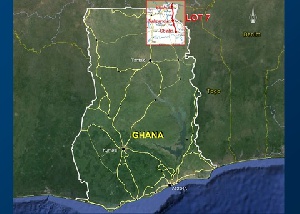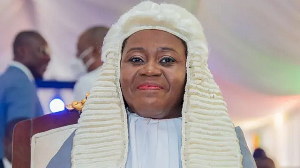I am not a warmonger. I am not an ethnocentrist. Neither am I, by my posture, arguments, discussions, write-ups and opinions, seeking to know more than my audience. I believe that there are millions and thousands of people out there who are older and more knowledgeable than me. I am only being a realist or a pragmatic with sometimes hardtalks, even though I may need more education, information and wisdom in the way I carry myself and aggression with my arguments.
A CASE OF BALKANIZATION OF DAGBON?
It is repugnant to hear such peddled untruths, or call it propaganda that Dagbon as a ‘Kingdom’ would weaken when the Eastern Corridor Region is created. It is OK to forgive these kinds of young, ill-informed, and ANTI-NPP commentators who will go at length, with their Communist Inferior tactics to satisfy their paymasters. If it were the NDC regime (i.e remember the NDC in 2016 promised to create regions including the Eastern Corridor Region) I don't think that this surrogacy would have cropped up since those few people are always ready with their buffoonery to support the NDC even when SADA guinea fowls are flying to Burkina Faso.
When I hear these unsubstantiated myths circulated that the Eastern Corridor Region would balkanize or weaken Dagbon 'kingdom', I ask "come again". "Ka man HOW?" I ask the learned professor and historian, how an administrative region has a relationship with a traditional setup with well demarcated jurisdiction and backed by law i.e. see the Chieftaincy Act.
If such opinions are not for parochial interests then let your research findings be made available and clear so that people like me can take a better position. As a member of COALITION OF EASTERN CORRIDOR YOUTH and a development practitioner I am free to hold my assumptions in favour of the clamour for the creation of the region.
My little findings, though I stand for corrections, show that people often liken the creation of the EASTERN CORRIDOR REGION to the historical PARTITION OF DAGBON somewhere in 1899 and the unfortunate incidences that came with it. We are told that under this partition, or call it a convention signed between the BRITAIN and GERMANY, DAGBON was torn between two colonial boundaries and territories under which the chiefs and people, some at WESTERN DAGBON and some at EASTERN DAGBON could not cross the boundaries.
We are told that the partition of Dagbon created intense friction between Ya Naa Alasani on the one hand and Yani gate skins in Western Dagbon on the other. (Refer to ABRIDGED HISTORY OF DAGBON', 'The Lions of Dagbon' etc). This partition of Dagbon could have far reaching ramifications on Dagbon.
But I think that happenings during that period and happenings under the proposed EASTERN CORRIDOR REGION are not same. Dagbon is not to be partitioned and cannot be partitioned.
The question to ask is "does the current boundaries between and among districts and towns of Dagomba land amount to partition??? The boundaries of Dagbon kingdom and its territory is known from all the four corners of the kingdom, and it is bounded by its traditional boundaries. The boundaries and territories then are similar to the boundaries and territories today between TWO DIFFERENT COUNTRIES.
Through the ECOWAS, AU, UN and others, conventions and treaties have now even allowed passports and other requirements as prerequisites enough to allow a NON-NATIONAL cross borders to another country. Crossing borders between TWO REGIONS e.g. Northern and Upper West regions within the same country is legally, naturally and practically allowed under the current political democratic dispensation.
If traditional namship had influencing relationship with modern political administration i.e. with ethnic groups in legion and under one President, then Sambu (the traditional capital of the Mion District should have been selected to be the administrative capital when it was created). Similarly, what is the traditional capital of Dagbon?
Don't we have our revered divisional chiefs from different districts and towns pay allegiance to the Yani Skin in Yendi? What about Mamprugu land, what about Nanung land? What about the Ashanti Kingdom which stretches to parts of Brong Ahafo, Western, Central, Eastern, and Volta?
In 2014 the Kukuomhene of Brong Ahafo, and a chief under the Asantehene was the President of the Brong Ahafo Regional House of Chiefs. Do all these arrangements weaken the Asante kingdom?
You can ask many questions and it will boil down to one clear thing POLITICAL ADMINISTRATION IS DIFFERENT FROM TRADITION AND CHIEFTAINCY. So those making the propaganda capital along ethnic arguments should rethink. FINITO!!!
GEOGRAPHICAL VASTNESS
It is a fact that the Northern Region, as presently constituted, is far too big to remain under one central administration. It covers the largest piece of land in Ghana with its land size of 70,384km2 out of Ghana’s land size of 237,626m2. It thus, covers about one-third (29.62 percent) of Ghana’s land mass, half of which is arguably far bigger than the total landmass of Greater Accra, Upper West, Upper East and Central Regions put together. It is over 5 times the size of either of the two Upper Regions, and more than twice the size of the largest of the Southern regions. Its vastness makes it far exceedingly difficult for effective administration, since the towns are very scattered.
As part of the Golden Jubilee lecture in 2007 by Professor Kofi Kumado, Director of University of Ghana, Legon Center for International Affairs (LECIF), he indicated that the large and vast nature of the Northern Region makes it extremely difficult and too big to be administered by one Regional Minister. A visit to the Tatale/Sanguli area, Gusheigu/Karaga area, Bunkpurugu/Yunyoo area, Sang/Sambu area, Saboba/Chereponi area, Bimbila/Wulensi area, Kpandai area and many other villages and settlements surrounding Yendi Municipality, greets one with squalor, and sheer underdevelopment (lack of potable water, poor roads, poor health facilities, poor educational facilities et cetera) which are the practical effect of this large landmass.
This situation is also due to the fact that chunck of the resource allocation goes to the Regional Capital, as a Primate City, and few other towns to the neglect of remote towns and villages that need them the most. Per the 2010 population and housing census, 826,899 (79%) of the Northern Region's population live in the rural areas whereas only 219,464 (21%) live in the urban towns. This has resulted in lack of or inadequate infrastructure, roads, good health care, quality education, good drinking water among others.
The call for the creation of the new region is therefore to redistribute resource allocation to the benefit of the larger population in the rural areas. There has also been further peripheralization of sections of this region, which has historically been one of the most marginalized in all of Ghana. This explains why most of the settlements (e.g. Saboba, Tatale, Bimbila, Kpandai, and Wulensi) are cut off from many parts of the region and Ghana due to poor roads, particularly during the rainy reason. We believe that this unfortunate state of development has often been a push factor to many people, particularly men and women in their prime, who find themselves in the Southern part of Ghana particularly Accra and Kumasi as ‘Kayayei’.
HETEROGENEOUS NATURE OF THE AREA
The Eastern Corridor of the Northern Region of Ghana is a home to a lot of tribes, notably among them are Konkomba, Dagomba, Nanumba, Mamprusi, Chekosi, Basari, Bimoba, Gurma, Fulani, and many more. Our request thus, arises out of a general endorsement by the chiefs and people of the Eastern Corridor Area. Our call is above parochial interest and seeks to serve administrative prudence, enhance decentralization and bring hopes and national integration to the people who have been far removed from a lot of the development cakes.
POPULATION
The Ghana Population and Housing Census of 2010 quotes the population of the Northern Region as 2,479,461, half of which is arguably about the population size of Upper East and Upper West Regions put together. The total population of the towns and villages within the catchment area of the Eastern Corridor, that is Yendi, Gusheigu, Saboba, Chereponi, Mion, Tatale, Zabzugu, Nanumba North, Nanumba South, Karaga, Bunkpurugu-Yunyoo, Mamprusi East and West, as extracted from the same Population and Housing Census 2010 figures, is about 1,386,987 representing about 55.93% of the total population of the Northern Region.
This large population of the eastern corridor area is already bigger than the population of each of the Upper West and Upper East Regions. Considering the numbers, in terms of the population, the proposed Eastern Corridor Region stands tall against all other competing interests.
INFRASTRUCTURE FACILITIES
Basic infrastructure facilities for further development into regional status is nowhere near the Eastern Corridor in the entire Northern Region amongst the competing interests. It hosts all the decentralized departments, financial institutions, a referral hospital, Police and BNI divisions, military detachment, immigration services, branch offices for SSNIT, Ghana Revenue Authority, Volta River Authority/Northern Electricity Department Company, amongst others. Its economic activities can support the region if created. It thus has the necessary structures for an upgrade as sought by the chiefs and people of the area.
ORIGINAL POLITICAL IDENTITY
The greater portion of the proposed Eastern Corridor Region has an original political relationship which had Yendi as its District Capital. The first Republic had the Eastern Dagomba District which comprised the current Yendi, Gusheigu, Karaga, Chereponi, Saboba, Zabzugu, Tatale, Nanumba North and South, Kpandai, and Mion Districts.
This catchment area still fall under one division with supervision from Yendi as the headquarters for the Ghana Police Service, BNI, Ghana Prisons, Circuit Court and Ghana Fire Services. In a similar vein, it is under the operational area supervision of Yendi Social Security and National Insurance Trust, Ghana Revenue Authority offices and the Volta River Authority/Northern Electricity Department Company. The already existing political affinity bears testimony to a region in the making and underscores the top ranking status for the EASTERN CORRIDOR REGION.
STRATEGY TO END CONFLICTS
It is often said that “the devil finds work for the idle hands." The protracted Dagbon conflict, Nanumba Conflict, and many intra and inter-ethnic conflicts have often been blamed on socio-economic underdevelopment of the area. The Eastern Corridor Area in the Northern region is among the least developed geographical areas in Ghana. This explains the volatility of the North in terms of conflict.
Researchers often quote poverty as the third highest cause of conflicts in the northern region. When there is economic and social deprivation then there is despondency, desperation and invariably a call for coping and survival strategies of various kinds, including wars, stealing, robbery, among others. So our call for Eastern Corridor Region cannot be a misplaced priority other than to engage youth, reduce poverty and bring lasting peace to the Eastern Corridor area. The creation of the region comes with enormous social, political and economic benefits and opportunities that would engage a lot of people and reduce conflicts directly.
The large size of the Northern Region has also affected the ability of the Regional Minister and the Security service to rapidly respond to conflicts before they get out of hand. The Abudu-Andani 3-day clash which resulted in the demise of the Overlord of Dagbon, the murder of the Regent of Bimbilla, the chieftaincy clash in Bimbilla, the Bunkprugu conflict, among others could have been salvaged with proper, effective and efficient coordination between the Regional Capital and those affected scattered towns. The creation of the Regional Capital will no doubt facilitate effective coordination of the government business, bring governance to the door step of the masses, facilitate development and give each Regional Minister the chance to concentrate on a relatively smaller geographical area that he/she can effectively and efficiently manage.
A STRATEGY TO REDUCE COST OF TRANSPORTATION AND ACCELERATE DEVELOPMENT
The distance from the current Regional capital to the various district capitals is just too far. This poses serious hardship in terms of travel cost, stress, and risk to citizens who try to access government services that are centralized at the regional capital in Tamale. This phenomenon has serious implications to our perishable farm harvests, markets and commercialization.
It is our belief that when the Eastern Corridor region is created to include Bunkprugu, Yunyoo, Chereponi, Saboba, Gusheigu, Karaga, Tatale, Zabzugu, Bimbilla, Wulensi, Kpandai, Mion (Sang) and Yendi, with the capital sited at a town relatively proximate to all the major capitals of the Eastern Corridor, the needed accelerated development will be brought to the people of the Eastern Corridor.
Opinions of Tuesday, 14 November 2017
Columnist: Abubakari Is-haq Motariga















